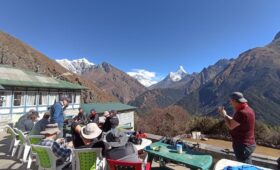Mountaineering has been very popular since the early 1900s. And Nepal comes in the frontline more than any other country regarding mountaineering. Whether it is from the first expedition of George Mallory or the recent ones from Kristin Harilla, the Himalayas of Nepal have called mountaineers from all around the world.
Talking about the Himalayas, the Everest Region is the one that should not be missed. The mountains from this region (from Mahalangur Range) are the ones that represent Nepal in the world. From Everest to Lhotse, these peaks are among the fourteen 8000 ers in the world.
Nestled alongside the Mahalangur Range, an Island Peak has been climbed as a practice expedition before Mount Everest. It stands at 6,165 meters above sea level and is one of the pinnacles of the Khumjung Everest Region. Here, we will discuss the Island Peak Expedition, the best time to do it, and the essential preparations needed.
Best Time to Climb Island Peak
Looking at Nepal’s weather and climate conditions, the best time for climbing Island Peak is Spring and August. During these timeframes, the weather is generally stable, which makes it more convenient to reach the top of Island Peak. Here are some reasons why these times are considered the best;
Spring (March to May):
Spring, which starts in March and ends in May, brings many cherishes to Nepal. This season offers everything from colorful surroundings to the clear and transparent vistas of the mountains.
First things first, Spring is the season of colors. The blooming rhododendron forests en route to the Island Peak Base Camp will soar the beauty of this expedition. Similarly, the trees go into full-fledged greenery, offering one of the most breathtaking views.
Spring has one of the most favorable weather conditions. The temperature is moderate, with an average of 18°C during the daytime and around -12 °C at night. In addition, there is minimal chance of rainfall and snowfall during the Spring season, which makes it convenient for climbers to navigate through the remote trails to reach the Base Camp. Less snowfall means easy getaway to the top of Island Peak from the Base Camp.
Autumn (September to November):
Autumn is another peak season to climb Island Peak. Like the Spring, this season also comes with stable weather conditions. The temperature is moderate and favorable for trekking and climbing the snow-capped peaks. The average temperature during Autumn in the Island Peak region ranges from around 20°C during the daytime to around 5°C at night.
During Autumn, there are fewer clouds in the sky, which offers a great chance to experience the scenic beauty of Mount Island Peak, Lobuche, Mount Everest, Cho Oyu, and Ama Dablam.
Similarly, Autumn brings several festivals in Nepal, including major celebrations like Dashain and Tihar. During these times, travel agencies not only offer discounts & deals but also help in cultural immersion and other related activities in the Everest Region, where Island Peak is located
Difficulty Level of Climbing Island Peak
It is evident that climbing any peak globally is a challenging feat, and the same goes for Island Peak. Climbers must be affluent with mountaineering and technical climbing skills to scale the Island Peak. So it is recommended to have prior experience before embarking on this expedition.
The most important thing to know is that Island Peak is a multi-day package. First, climbers must reach the Base Camp, acclimatize, and prepare for the climb. Reaching the Island Peak Base Camp itself takes more than a week. The trek is hazardous, featured with remote & uphill climbs through the uneven terrains. Similarly, high altitude places can bring the risk of altitude sickness and other dangers to mountaineers.
Pushing for the summit from the base camp is the next challenging task. The route to the top of Island Peak is very steep, slippery, and treacherous. With just one misstep from the route, climbers can lose their life on the verge of climbing Island Peak.
Similarly, the weather condition of the Himalayas is very unpredictable. Extremely low temperatures, strong winds, and high altitudes can play a significant role in failing the expedition. Most of the time, climbers suffer from altitude sickness and other related illnesses, including HAPE (High Altitude Pulmonary Edema) and HACE (High Altitude Cerebral Edema). That’s why mountaineers should always strictly plan before embarking on this journey.
Itinerary For Climbing Island Peak
- Day 1: Flight to Lukla (2850m/9,350ft) | Trek to Phakding (2,650m/8,690ft)
- Day 2: Trek from Phakding (2,650m/8,690ft) to Namche Bazaar (3440m/11,285ft)
- Day 3: Acclimatize at Namche Bazaar (3440m/11,285ft)
- Day 4: Trek from Namche Bazaar (3440m/11,285ft) to Tengboche (3,855m/12,850ft)
- Day 5: Trek from Tengboche (3,855m/12,850ft) to Dingboche (4,360m/14,290ft)
- Day 6: Trek from Dingboche (4,360m/14,290ft) to Chhukung (4735m/15,535ft) 3 Hours
- Day 7: Acclimatize at Chukung (4735m/15,535ft)
- Day 8: Trek from Chhukung (4735m/15,535ft) to Island Peak Base Camp (5,200m/ 17,050ft)
- Day 9: Summit Island Peak (6,183m) and return to Chukung (4735m/15,535ft)
- Day 10: Trek from Chhukung (4,730m/15,518ft) to Tengboche (3,870m/12,304ft)
- Day 11: Trek from Tengboche (3,870m/12,304ft) to Namche (3440m/11,285ft)
- Day 12: Trek from Namche (3440m/11,285ft) to Lukla (2850m/9,350ft) 6-7 hrs
- Day 13: Fly from Lukla (2,850 m/9,350 ft) to Kathmandu (1,400m/4,593ft)
How To Prepare For Climbing Island Peak?
As mentioned, preparation must be on the topmost level before climbing Island Peak. Since the difficulty level is challenging, your preparation ensures your safety and act of being safe in case of emergencies or natural hazards. Here are some tips to prepare for climbing Island Peak:
Physical & Mental Preparation:
Peak climbing is not only an adventurous but a life-threatening job. It requires a huge level of dedication and preparation. When it comes to climbing Island Peak requires a high level of physical and mental fitness. First things first, the total duration of this expedition prolongs for over a couple of weeks. And it includes over 6 to 7 hours of straight walk through the Alpine Himalayan Terrains. It simply shows why your physical fitness matters.
Similarly, up from the base camp, the route to the summit is very steep and slippery. On top of that, the low temperature and high altitude punch you making it difficult to breathe. Here, strong lungs power, engined with stamina, energy, and endurance, makes the work.
Regarding mental preparation, climbers must acknowledge the risks Island Peak poses. They should be ready to face the mountaineering barriers and adjust their mindset accordingly.
Train Yourself For Climbing:
Climbing Island Peak requires prior mountaineering experience as it is not easy to climb this Himalayan Peak. Nestled in the Everest Region of Nepal, this peak poses numerous risks that threaten human life. The treacherous landscapes, weather, climate, and high altitude are some major aspects contributing to the risks.
To avoid or minimize the risk, climbers must have prior mountaineering experience and rock climbing training. The landscape of Island Peak is rocky and steep, where having a rock climbing experience makes sense. Similarly, technical climbing skills, such as using ice axes, crampons, gaiters, carabiners, and fixed ropes, are also very necessary.
Choose The Best Time for Climbing:
Climbers must be aware of Nepal’s weather conditions at different timeframes of the year. This will help them know when and how to launch the Island Peak Expedition that meets their expectations. Usually, Spring and Autumn seasons are considered the best times to climb Island Peak. Looking at the weather condition, temperature, the level of the beautiful scenery it offers, and the cost, these seasons might be the first thing to put in your basket list for Island Peak Climbing.
When it comes to off-peak seasons like monsoon and winter, there is a high probability of snowfall and rainfall. This makes navigation challenging and threatens climbers’ health and life. Similarly, natural hazards like landslides and avalanches also contribute to the risks associated with mountaineering.
Do you have any question about trip to Nepal?
Tell us about your trip to Nepal and what you expect from it. We will answer your questions in 24 hours and help you design a trip with a comfortable itinerary to best meet your needs.





